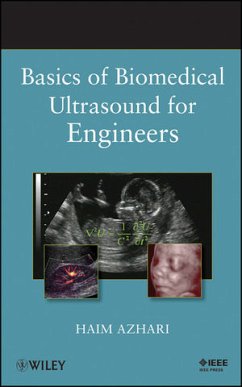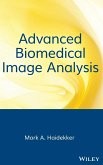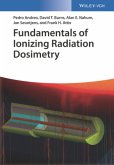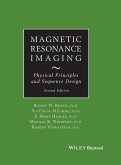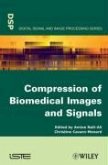Haim Azhari
Basics of Biomedical Ultrasound for Engineers
Haim Azhari
Basics of Biomedical Ultrasound for Engineers
- Gebundenes Buch
- Merkliste
- Auf die Merkliste
- Bewerten Bewerten
- Teilen
- Produkt teilen
- Produkterinnerung
- Produkterinnerung
Basics of Biomedical Ultrasound for Engineers is a structured textbook for university engineering courses in biomedical ultrasound and for researchers in the field. This book offers a tool for building a solid understanding of biomedical ultrasound, and leads the novice through the field in a step-by-step manner. The book begins with the most basic definitions of waves, proceeds to ultrasounds in fluids, and then delves into solid ultrasounds, the most complicated kind of ultrasound. It encompasses a wide range of topics within biomedical ultrasound, from conceptual definitions of waves to the…mehr
Andere Kunden interessierten sich auch für
![Biomedical Image w/WS Biomedical Image w/WS]() Mark HaidekkerBiomedical Image w/WS198,99 €
Mark HaidekkerBiomedical Image w/WS198,99 €![Fundamentals of Ionizing Radiation Dosimetry / Fundamentals of Ionizing Radiation Dosimetry Fundamentals of Ionizing Radiation Dosimetry / Fundamentals of Ionizing Radiation Dosimetry]() Pedro AndreoFundamentals of Ionizing Radiation Dosimetry / Fundamentals of Ionizing Radiation Dosimetry161,99 €
Pedro AndreoFundamentals of Ionizing Radiation Dosimetry / Fundamentals of Ionizing Radiation Dosimetry161,99 €![Biomimetic Materials Chemistry Biomimetic Materials Chemistry]() Stephen Mann (Hrsg.)Biomimetic Materials Chemistry428,99 €
Stephen Mann (Hrsg.)Biomimetic Materials Chemistry428,99 €![Magnetic Resonance Imaging Magnetic Resonance Imaging]() Robert W BrownMagnetic Resonance Imaging288,99 €
Robert W BrownMagnetic Resonance Imaging288,99 €![Collaborative Computational Technologies for Biomedical Research Collaborative Computational Technologies for Biomedical Research]() Collaborative Computational Technologies for Biomedical Research184,99 €
Collaborative Computational Technologies for Biomedical Research184,99 €![Prüf- und Bewertungsmethoden für Knieorthesen Prüf- und Bewertungsmethoden für Knieorthesen]() David HochmannPrüf- und Bewertungsmethoden für Knieorthesen124,95 €
David HochmannPrüf- und Bewertungsmethoden für Knieorthesen124,95 €![Compression of Biomedical Images and Signals Compression of Biomedical Images and Signals]() Compression of Biomedical Images and Signals213,99 €
Compression of Biomedical Images and Signals213,99 €-
-
-
Basics of Biomedical Ultrasound for Engineers is a structured textbook for university engineering courses in biomedical ultrasound and for researchers in the field. This book offers a tool for building a solid understanding of biomedical ultrasound, and leads the novice through the field in a step-by-step manner. The book begins with the most basic definitions of waves, proceeds to ultrasounds in fluids, and then delves into solid ultrasounds, the most complicated kind of ultrasound. It encompasses a wide range of topics within biomedical ultrasound, from conceptual definitions of waves to the intricacies of focusing devices, transducers, and acoustic fields.
Hinweis: Dieser Artikel kann nur an eine deutsche Lieferadresse ausgeliefert werden.
Hinweis: Dieser Artikel kann nur an eine deutsche Lieferadresse ausgeliefert werden.
Produktdetails
- Produktdetails
- Verlag: John Wiley & Sons / Wiley
- Seitenzahl: 392
- Erscheinungstermin: 5. März 2010
- Englisch
- Abmessung: 247mm x 164mm x 25mm
- Gewicht: 691g
- ISBN-13: 9780470465479
- ISBN-10: 0470465476
- Artikelnr.: 26175065
- Herstellerkennzeichnung
- Libri GmbH
- Europaallee 1
- 36244 Bad Hersfeld
- gpsr@libri.de
- Verlag: John Wiley & Sons / Wiley
- Seitenzahl: 392
- Erscheinungstermin: 5. März 2010
- Englisch
- Abmessung: 247mm x 164mm x 25mm
- Gewicht: 691g
- ISBN-13: 9780470465479
- ISBN-10: 0470465476
- Artikelnr.: 26175065
- Herstellerkennzeichnung
- Libri GmbH
- Europaallee 1
- 36244 Bad Hersfeld
- gpsr@libri.de
HAIM AZHARI, DSc, conducts research in medical imaging, including the application of ultrasound and MRI in medical imaging, image tomographic reconstruction, image processing, and information extraction from medical images. Professor Azhari received his doctorate in biomedical engineering from the Technion-Israel Institute of Technology in 1987. From 1987 to 1990, he was on the staff of the Technion Department of Biomedical Engineering in a postdoctoral position. Azhari then received a double appointment as an International Research Fellow in both the Department of Radiology and the Division of Cardiology at the Johns Hopkins School of Medicine in Baltimore, Maryland. Upon his return to Israel in 1992, he joined the Department of Biomedical Engineering at the Technion-IIT as a staff member, where he is currently an associate professor. From 1999-2000, Azhari was at Harvard Medical School in the Beth-Israel Radiology Department.
Preface.
Acknowledgments.
Introduction.
Prelude and Basic Definitions.
The Advantages of Using Ultrasound in Medicine.
A General Statement on Safety.
Some Common Applications of Ultrasound.
What Is It that We Need to Know?
References.
1 Waves-A General Description.
1.1 General Definitions of Waves-A Qualitative Description.
1.2 General Properties of Waves-A Qualitative Description.
1.3 Mechanical One-Dimensional Waves.
1.4 The Wave Function.
1.5 The Wave Equation.
1.6 Harmonic Waves.
1.7 Group Waves.
1.8 Wave Velocity.
1.9 Standing Waves (a Mathematical Description).
1.10 Spherical Waves.
1.11 Cylindrical Waves.
1.12 The Wave Equation in a Nonhomogeneous Medium.
References.
2 Waves In A One-Dimensional Medium.
2.1 The Propagation Speed of Transverse Waves in a String.
2.2 Vibration Frequencies for a Bounded String.
2.3 Wave Reflection (Echo) in a One-Dimensional Medium.
2.4 Special Cases.
2.5 Wave Energy in Strings.
2.6 Propagation of Longitudinal Waves in an Isotropic Rod or String.
2.7 A Clinical Application of Longitudinal Waves in a String.
References.
3 Ultraspmoc Waves in Fluids.
3.1 Waves in Fluids.
3.2 Compressibility.
3.3. Longitudinal Waves in Fluids.
3.4 The Wave Energy.
3.5 Intensity.
3.6 Radiation Pressure.
3.7 A Perfect Reflector.
References.
4 Propogation of Acoustic Waves in Solid Materials.
4.1 Introduction to the Mechanics of Solids.
4.2 The Elastic Strain.
4.3 Stress.
4.4 Hooke's Law and Elastic Coefficients.
4.5 The Wave Equation for an Elastic Solid Material.
4.6 Propagation of a Harmonic Planar Wave in a Solid Material.
References.
5 Attenuation and Dispersion.
5.1 The Attenuation Phenomenon.
5.2 Explaining Attenuation with a Simple Model.
5.3 Attenuation Dependency on Frequency.
5.4 The Complex Wave Number.
5.5 Speed of Sound Dispersion.
5.6 The Nonlinear Parameter B/A.
References.
6 Reflection and Transmission.
6.1 The Acoustic Impedance.
6.2 Snell's Law.
6.3 Reflection and Transmission from Boundaries Separating Two Fluids (or
Solids with No Shear Waves).
6.4 Reflection from a Free Surface in Solids (Mode Conversion).
6.5 Reflection and Transmission from a Liquid- Solid Boundary.
References.
7 ACOUSTIC LENSES AND MIRRORS.
7.1 Optics.
7.2 Optics and Acoustics.
7.3 An Ellipsoidal Lens.
7.4 Spherical Lenses.
7.5 Zone Lenses.
7.6 Acoustic Mirrors (Focusing Reflectors).
References.
8 Transducers and Acoustic Fields.
8.1 Piezoelectric Transducers.
8.2 The Acoustic Field.
8.3 The Field of a Point Source.
8.4 The Field of a Disc Source.
8.5 The Field of Various Transducers.
8.6 Phased-Array Transducers.
8.7 Annular Phased Arrays.
References.
9 Ultrasonic Imaging Using the Pulse-Echo Technique.
9.1 Basic Definitions in Imaging.
9.2 The "A-Line".
9.3 Scatter Model for Soft Tissues.
9.4 Time Gain Compensation.
9.5 Basic Pulse-Echo Imaging (B-Scan).
9.6 Advanced Methods for Pulse-Echo Imaging.
References.
10 Special Imaging Techniques.
10.1 Acoustic Impedance Imaging-Impediography.
10.2 Elastography.
10.3 Tissue Speckle Tracking.
10.4 Through-Transmission Imaging.
10.5 Vibro-acoustic Imaging.
10.6 Time Reversal.
10.7 Ultrasonic Computed Tomography.
10.8 Contrast Materials.
10.9 Coded Excitations.
References.
11 Doppler Imaging Techniques.
11.1 The Doppler Effect.
11.2 Velocity Estimation.
11.3 Frequency Shift Estimation.
11.4 Duplex Imaging (Combined B-Scan and Color Flow Mapping).
References.
12 Safety and Therapuetic Applications.
12.1 Effects Induced by Ultrasound and Safety.
12.2 Ultrasonic Physiotherapy.
12.3 Lithotripsy.
12.4 Hyperthermia HIFU and Ablation.
12.5 Drug Delivery.
12.6 Gene Therapy.
12.7 Cosmetic Applications.
References.
Appenidx A: Typical Acoustic Properties of Tissues.
Appendix B: Exemplary Problems.
Appendix C: Answers to Exemplary Problems.
Index.
Acknowledgments.
Introduction.
Prelude and Basic Definitions.
The Advantages of Using Ultrasound in Medicine.
A General Statement on Safety.
Some Common Applications of Ultrasound.
What Is It that We Need to Know?
References.
1 Waves-A General Description.
1.1 General Definitions of Waves-A Qualitative Description.
1.2 General Properties of Waves-A Qualitative Description.
1.3 Mechanical One-Dimensional Waves.
1.4 The Wave Function.
1.5 The Wave Equation.
1.6 Harmonic Waves.
1.7 Group Waves.
1.8 Wave Velocity.
1.9 Standing Waves (a Mathematical Description).
1.10 Spherical Waves.
1.11 Cylindrical Waves.
1.12 The Wave Equation in a Nonhomogeneous Medium.
References.
2 Waves In A One-Dimensional Medium.
2.1 The Propagation Speed of Transverse Waves in a String.
2.2 Vibration Frequencies for a Bounded String.
2.3 Wave Reflection (Echo) in a One-Dimensional Medium.
2.4 Special Cases.
2.5 Wave Energy in Strings.
2.6 Propagation of Longitudinal Waves in an Isotropic Rod or String.
2.7 A Clinical Application of Longitudinal Waves in a String.
References.
3 Ultraspmoc Waves in Fluids.
3.1 Waves in Fluids.
3.2 Compressibility.
3.3. Longitudinal Waves in Fluids.
3.4 The Wave Energy.
3.5 Intensity.
3.6 Radiation Pressure.
3.7 A Perfect Reflector.
References.
4 Propogation of Acoustic Waves in Solid Materials.
4.1 Introduction to the Mechanics of Solids.
4.2 The Elastic Strain.
4.3 Stress.
4.4 Hooke's Law and Elastic Coefficients.
4.5 The Wave Equation for an Elastic Solid Material.
4.6 Propagation of a Harmonic Planar Wave in a Solid Material.
References.
5 Attenuation and Dispersion.
5.1 The Attenuation Phenomenon.
5.2 Explaining Attenuation with a Simple Model.
5.3 Attenuation Dependency on Frequency.
5.4 The Complex Wave Number.
5.5 Speed of Sound Dispersion.
5.6 The Nonlinear Parameter B/A.
References.
6 Reflection and Transmission.
6.1 The Acoustic Impedance.
6.2 Snell's Law.
6.3 Reflection and Transmission from Boundaries Separating Two Fluids (or
Solids with No Shear Waves).
6.4 Reflection from a Free Surface in Solids (Mode Conversion).
6.5 Reflection and Transmission from a Liquid- Solid Boundary.
References.
7 ACOUSTIC LENSES AND MIRRORS.
7.1 Optics.
7.2 Optics and Acoustics.
7.3 An Ellipsoidal Lens.
7.4 Spherical Lenses.
7.5 Zone Lenses.
7.6 Acoustic Mirrors (Focusing Reflectors).
References.
8 Transducers and Acoustic Fields.
8.1 Piezoelectric Transducers.
8.2 The Acoustic Field.
8.3 The Field of a Point Source.
8.4 The Field of a Disc Source.
8.5 The Field of Various Transducers.
8.6 Phased-Array Transducers.
8.7 Annular Phased Arrays.
References.
9 Ultrasonic Imaging Using the Pulse-Echo Technique.
9.1 Basic Definitions in Imaging.
9.2 The "A-Line".
9.3 Scatter Model for Soft Tissues.
9.4 Time Gain Compensation.
9.5 Basic Pulse-Echo Imaging (B-Scan).
9.6 Advanced Methods for Pulse-Echo Imaging.
References.
10 Special Imaging Techniques.
10.1 Acoustic Impedance Imaging-Impediography.
10.2 Elastography.
10.3 Tissue Speckle Tracking.
10.4 Through-Transmission Imaging.
10.5 Vibro-acoustic Imaging.
10.6 Time Reversal.
10.7 Ultrasonic Computed Tomography.
10.8 Contrast Materials.
10.9 Coded Excitations.
References.
11 Doppler Imaging Techniques.
11.1 The Doppler Effect.
11.2 Velocity Estimation.
11.3 Frequency Shift Estimation.
11.4 Duplex Imaging (Combined B-Scan and Color Flow Mapping).
References.
12 Safety and Therapuetic Applications.
12.1 Effects Induced by Ultrasound and Safety.
12.2 Ultrasonic Physiotherapy.
12.3 Lithotripsy.
12.4 Hyperthermia HIFU and Ablation.
12.5 Drug Delivery.
12.6 Gene Therapy.
12.7 Cosmetic Applications.
References.
Appenidx A: Typical Acoustic Properties of Tissues.
Appendix B: Exemplary Problems.
Appendix C: Answers to Exemplary Problems.
Index.
Preface.
Acknowledgments.
Introduction.
Prelude and Basic Definitions.
The Advantages of Using Ultrasound in Medicine.
A General Statement on Safety.
Some Common Applications of Ultrasound.
What Is It that We Need to Know?
References.
1 Waves-A General Description.
1.1 General Definitions of Waves-A Qualitative Description.
1.2 General Properties of Waves-A Qualitative Description.
1.3 Mechanical One-Dimensional Waves.
1.4 The Wave Function.
1.5 The Wave Equation.
1.6 Harmonic Waves.
1.7 Group Waves.
1.8 Wave Velocity.
1.9 Standing Waves (a Mathematical Description).
1.10 Spherical Waves.
1.11 Cylindrical Waves.
1.12 The Wave Equation in a Nonhomogeneous Medium.
References.
2 Waves In A One-Dimensional Medium.
2.1 The Propagation Speed of Transverse Waves in a String.
2.2 Vibration Frequencies for a Bounded String.
2.3 Wave Reflection (Echo) in a One-Dimensional Medium.
2.4 Special Cases.
2.5 Wave Energy in Strings.
2.6 Propagation of Longitudinal Waves in an Isotropic Rod or String.
2.7 A Clinical Application of Longitudinal Waves in a String.
References.
3 Ultraspmoc Waves in Fluids.
3.1 Waves in Fluids.
3.2 Compressibility.
3.3. Longitudinal Waves in Fluids.
3.4 The Wave Energy.
3.5 Intensity.
3.6 Radiation Pressure.
3.7 A Perfect Reflector.
References.
4 Propogation of Acoustic Waves in Solid Materials.
4.1 Introduction to the Mechanics of Solids.
4.2 The Elastic Strain.
4.3 Stress.
4.4 Hooke's Law and Elastic Coefficients.
4.5 The Wave Equation for an Elastic Solid Material.
4.6 Propagation of a Harmonic Planar Wave in a Solid Material.
References.
5 Attenuation and Dispersion.
5.1 The Attenuation Phenomenon.
5.2 Explaining Attenuation with a Simple Model.
5.3 Attenuation Dependency on Frequency.
5.4 The Complex Wave Number.
5.5 Speed of Sound Dispersion.
5.6 The Nonlinear Parameter B/A.
References.
6 Reflection and Transmission.
6.1 The Acoustic Impedance.
6.2 Snell's Law.
6.3 Reflection and Transmission from Boundaries Separating Two Fluids (or
Solids with No Shear Waves).
6.4 Reflection from a Free Surface in Solids (Mode Conversion).
6.5 Reflection and Transmission from a Liquid- Solid Boundary.
References.
7 ACOUSTIC LENSES AND MIRRORS.
7.1 Optics.
7.2 Optics and Acoustics.
7.3 An Ellipsoidal Lens.
7.4 Spherical Lenses.
7.5 Zone Lenses.
7.6 Acoustic Mirrors (Focusing Reflectors).
References.
8 Transducers and Acoustic Fields.
8.1 Piezoelectric Transducers.
8.2 The Acoustic Field.
8.3 The Field of a Point Source.
8.4 The Field of a Disc Source.
8.5 The Field of Various Transducers.
8.6 Phased-Array Transducers.
8.7 Annular Phased Arrays.
References.
9 Ultrasonic Imaging Using the Pulse-Echo Technique.
9.1 Basic Definitions in Imaging.
9.2 The "A-Line".
9.3 Scatter Model for Soft Tissues.
9.4 Time Gain Compensation.
9.5 Basic Pulse-Echo Imaging (B-Scan).
9.6 Advanced Methods for Pulse-Echo Imaging.
References.
10 Special Imaging Techniques.
10.1 Acoustic Impedance Imaging-Impediography.
10.2 Elastography.
10.3 Tissue Speckle Tracking.
10.4 Through-Transmission Imaging.
10.5 Vibro-acoustic Imaging.
10.6 Time Reversal.
10.7 Ultrasonic Computed Tomography.
10.8 Contrast Materials.
10.9 Coded Excitations.
References.
11 Doppler Imaging Techniques.
11.1 The Doppler Effect.
11.2 Velocity Estimation.
11.3 Frequency Shift Estimation.
11.4 Duplex Imaging (Combined B-Scan and Color Flow Mapping).
References.
12 Safety and Therapuetic Applications.
12.1 Effects Induced by Ultrasound and Safety.
12.2 Ultrasonic Physiotherapy.
12.3 Lithotripsy.
12.4 Hyperthermia HIFU and Ablation.
12.5 Drug Delivery.
12.6 Gene Therapy.
12.7 Cosmetic Applications.
References.
Appenidx A: Typical Acoustic Properties of Tissues.
Appendix B: Exemplary Problems.
Appendix C: Answers to Exemplary Problems.
Index.
Acknowledgments.
Introduction.
Prelude and Basic Definitions.
The Advantages of Using Ultrasound in Medicine.
A General Statement on Safety.
Some Common Applications of Ultrasound.
What Is It that We Need to Know?
References.
1 Waves-A General Description.
1.1 General Definitions of Waves-A Qualitative Description.
1.2 General Properties of Waves-A Qualitative Description.
1.3 Mechanical One-Dimensional Waves.
1.4 The Wave Function.
1.5 The Wave Equation.
1.6 Harmonic Waves.
1.7 Group Waves.
1.8 Wave Velocity.
1.9 Standing Waves (a Mathematical Description).
1.10 Spherical Waves.
1.11 Cylindrical Waves.
1.12 The Wave Equation in a Nonhomogeneous Medium.
References.
2 Waves In A One-Dimensional Medium.
2.1 The Propagation Speed of Transverse Waves in a String.
2.2 Vibration Frequencies for a Bounded String.
2.3 Wave Reflection (Echo) in a One-Dimensional Medium.
2.4 Special Cases.
2.5 Wave Energy in Strings.
2.6 Propagation of Longitudinal Waves in an Isotropic Rod or String.
2.7 A Clinical Application of Longitudinal Waves in a String.
References.
3 Ultraspmoc Waves in Fluids.
3.1 Waves in Fluids.
3.2 Compressibility.
3.3. Longitudinal Waves in Fluids.
3.4 The Wave Energy.
3.5 Intensity.
3.6 Radiation Pressure.
3.7 A Perfect Reflector.
References.
4 Propogation of Acoustic Waves in Solid Materials.
4.1 Introduction to the Mechanics of Solids.
4.2 The Elastic Strain.
4.3 Stress.
4.4 Hooke's Law and Elastic Coefficients.
4.5 The Wave Equation for an Elastic Solid Material.
4.6 Propagation of a Harmonic Planar Wave in a Solid Material.
References.
5 Attenuation and Dispersion.
5.1 The Attenuation Phenomenon.
5.2 Explaining Attenuation with a Simple Model.
5.3 Attenuation Dependency on Frequency.
5.4 The Complex Wave Number.
5.5 Speed of Sound Dispersion.
5.6 The Nonlinear Parameter B/A.
References.
6 Reflection and Transmission.
6.1 The Acoustic Impedance.
6.2 Snell's Law.
6.3 Reflection and Transmission from Boundaries Separating Two Fluids (or
Solids with No Shear Waves).
6.4 Reflection from a Free Surface in Solids (Mode Conversion).
6.5 Reflection and Transmission from a Liquid- Solid Boundary.
References.
7 ACOUSTIC LENSES AND MIRRORS.
7.1 Optics.
7.2 Optics and Acoustics.
7.3 An Ellipsoidal Lens.
7.4 Spherical Lenses.
7.5 Zone Lenses.
7.6 Acoustic Mirrors (Focusing Reflectors).
References.
8 Transducers and Acoustic Fields.
8.1 Piezoelectric Transducers.
8.2 The Acoustic Field.
8.3 The Field of a Point Source.
8.4 The Field of a Disc Source.
8.5 The Field of Various Transducers.
8.6 Phased-Array Transducers.
8.7 Annular Phased Arrays.
References.
9 Ultrasonic Imaging Using the Pulse-Echo Technique.
9.1 Basic Definitions in Imaging.
9.2 The "A-Line".
9.3 Scatter Model for Soft Tissues.
9.4 Time Gain Compensation.
9.5 Basic Pulse-Echo Imaging (B-Scan).
9.6 Advanced Methods for Pulse-Echo Imaging.
References.
10 Special Imaging Techniques.
10.1 Acoustic Impedance Imaging-Impediography.
10.2 Elastography.
10.3 Tissue Speckle Tracking.
10.4 Through-Transmission Imaging.
10.5 Vibro-acoustic Imaging.
10.6 Time Reversal.
10.7 Ultrasonic Computed Tomography.
10.8 Contrast Materials.
10.9 Coded Excitations.
References.
11 Doppler Imaging Techniques.
11.1 The Doppler Effect.
11.2 Velocity Estimation.
11.3 Frequency Shift Estimation.
11.4 Duplex Imaging (Combined B-Scan and Color Flow Mapping).
References.
12 Safety and Therapuetic Applications.
12.1 Effects Induced by Ultrasound and Safety.
12.2 Ultrasonic Physiotherapy.
12.3 Lithotripsy.
12.4 Hyperthermia HIFU and Ablation.
12.5 Drug Delivery.
12.6 Gene Therapy.
12.7 Cosmetic Applications.
References.
Appenidx A: Typical Acoustic Properties of Tissues.
Appendix B: Exemplary Problems.
Appendix C: Answers to Exemplary Problems.
Index.

